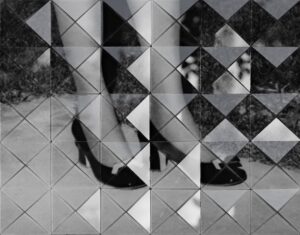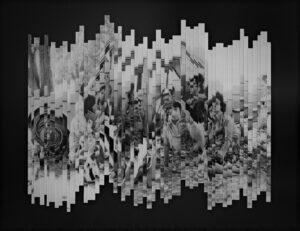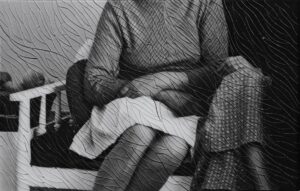Ali Tahayori On Mobilising Light, Āine-Kāri And His New Works For Melbourne Art Fair
Ali Tahayori’s interdisciplinary practice ranges from conceptual photography to the moving image, and installation. He uses archival materials, narrative fragments and performative modalities to explore themes of identity, home, and belonging. Combining fractured mirrors with text and imagery, his works draw on ancient Iranian philosophies about light and mirrors to create kaleidoscopic experiences; moments of both revelation and concealment hint at the conflicted nature of his identity. Born in Shiraz, Iran, Ali currently lives and works in Gadigal Country/Sydney.
Ali Tahayori is represented by THIS IS NO FANTASY, a Naarm/Melbourne based gallery, recognised for discovering and managing the careers of a small, select and diverse group of artists shaping Australia’s art discourse, both locally and internationally. Find THIS IS NO FANTASY and Ali Tahayori’s work at Melbourne Art Fair, Booth C4.
Committed to showcasing new and iconic artists with a focus on solo shows and works of scale and significance, Melbourne Art Fair spoke with Ali about his unique artistic practice.
An integral part of your work is your ability to translate the traditional Iranian craft of Āine-Kāri (mirror-works) into a contemporary visual vocabulary of your own. Can you expand on your fascination with this traditional craft and how you both embrace and subvert the notion of ‘tradition’ within your works?
My fascination with Āine-Kāri started when I was five years old, when, for the first time, I entered the shrine of Shah-Cheragh in my hometown, Shiraz, a mosque where the interior is covered with tiny mirror fragments. Being in that place was transcendental.
What I do in my practice is not translation as such, but mobilisation. I am interested in the notion of “hybridity”. I like moving ideas, materials, and processes across places and temporalities. If you look at the history of Āine-Kāri, you realize that the craft was developed to reuse and recycle broken mirrors imported from Europe. So, the mirrors were brought to Persia from another place, then turned into something uniquely Iranian, and now I am presenting my own version of it outside of Iran. By moving ideas and materials from one place to another, I question the notion of borders.

Detail image courtesy of the artist and THIS IS NO FANTASY.
Your works form to create a unique sensory experience through its kaleidoscopic effect. Can you elaborate on your consideration of light as a guiding principle in your work? Do you wish to exert a particular level of control over the light your work reflects or do you wish to relinquish a sense of control to the environment within which your works are shown and to who it is shown to?
Whether I work in Photography, moving image or installation, light is integral to my practice. I first became interested in light and studied it in my photography studio’s dark room, where everything dissolves in darkness. Then you introduce light, and something magical happens. That’s why I am more interested in video projections than showing the same video on a TV monitor; video projections reveal the luminous quality of images. In my video installations, I start with pure darkness and gradually introduce light. My approach to working with light is playful and experimental but also considered. Each project demands a particular aesthetic and sensory effect; based on that, the intensity, colour, contrast, and other qualities of light vary.
Expanding on the above, your work is deeply influenced by your personal experiences of being ‘othered’; from growing up in the homophobic environment of 1980s Iran to embodying the migrant experience through your move to Australia. How do your works reflect the complexities of identity and your experience of queerness, of being seen and unseen?
I work at the intersection of queer diasporic subjectivities and aim to amplify untold stories of violence and historical oppression, but also of resilience, community, belonging and celebration. The mirror, especially the way I use it, broken and fragmented, is a unique material to reflect on topics such as identity, queerness, and otherness while questioning the nature of representation.

Detail image courtesy of the artist and THIS IS NO FANTASY.
How does your process evolve when creating each work? How do you go from ideation to final artwork when working in a multi-disciplinary capacity ranging from photography, moving image and installation?
My approach to artmaking is intuitive and informed by research and my daily experience. A concept or an idea emerges, and it usually comes while I’m working on a different project. The concept then goes on a journey. I start researching the field in which I’m working, and the idea begins to find a material form. Material is a big part of my practice. There is often a dialogue between concept, material, and form. I try to be a good listener, but sometimes I’m not, and I only find out when the work is exhibited.
Can you provide any insights on the work you are developing for Melbourne Art Fair and how it relates to your broader body of work?
I am very excited to show a few works from my new project, Archive of Longing, at the Melbourne Art Fair, works I have not exhibited elsewhere yet. The project is, in a way, a return to the archive, and it embodies so many aspects of my practice: my interest in the materiality of images, questions of representation and photography’s in(ability) to represent reality, and my love and obsession with the medium’s history. Later in the year, I’ll exhibit part of this project in Milan and London.

Detail image courtesy of the artist and THIS IS NO FANTASY.
Explore and collect Ali Tahayori’s work at Melbourne Art Fair 2024. The Fair takes place 22 – 25 February at Melbourne Convention and Exhibition Centre. Secure tickets now.


